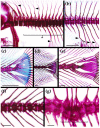Skeletal Anomalies in Senegalese Sole (Solea senegalensis, Kaup) Fed with Different Commercial Enriched Artemia: A Study in Postlarvae and Juveniles
- PMID: 33374441
- PMCID: PMC7823604
- DOI: 10.3390/ani11010022
Skeletal Anomalies in Senegalese Sole (Solea senegalensis, Kaup) Fed with Different Commercial Enriched Artemia: A Study in Postlarvae and Juveniles
Abstract
The high incidence of skeletal anomalies in Senegalese sole (Solea senegalensis) still constitutes a bottleneck constraining its production. There are diverse commercially available products for the enrichment of live preys, but few reports of their influence on skeletogenesis in Senegalese sole. This study evaluated the presence of vertebral anomalies in postlarvae and juvenile Senegalese sole fed with Artemia spp. metanauplii enriched with four commercial products (EA, EB, EC, and ED) in a fish farm. The most frequent alterations consisted of deformations of the neural/haemal arches and spines and fusions and deformations of hypurals, epural, or parhypural. The correspondence analysis ordered fish from each age in separated semiaxis, indicating the presence of different anomaly patterns for the two sampled stages. The results showed only very light changes in the frequency of vertebral abnormalities among tested enrichment products, i.e., individuals from EC and EA lots displayed less vertebral body anomalies and/or vertebral column deviations at 31 and 105 days after hatching, respectively. The existence of a large shared malformation pattern in all the experimental groups leads to impute to the rearing conditions as the main driving factor of the onset of such group of anomalies, probably masking some dietary effect.
Keywords: Senegalese sole (Solea senegalensis); enrichment products; rearing conditions; skeletal anomalies.
Conflict of interest statement
The authors declare no conflict of interest. Funders contributed to the design of the study; in the collection, in the revision of the manuscript; and in the decision to publish the results.
Figures





Similar articles
-
New insight on vertebral anomalies in cultured Senegalese sole (Solea senegalensis, Kaup) at early stages of development.J Fish Dis. 2017 Aug;40(8):987-1000. doi: 10.1111/jfd.12575. Epub 2016 Dec 21. J Fish Dis. 2017. PMID: 28000918
-
Skeletal anomalies in reared Senegalese sole Solea senegalensis juveniles: a radiographic approach.Dis Aquat Organ. 2017 Apr 20;124(2):117-129. doi: 10.3354/dao03110. Dis Aquat Organ. 2017. PMID: 28425425
-
A comprehensive coding and microRNA transcriptome of vertebral bone in postlarvae and juveniles of Senegalese sole (Solea senegalensis).Genomics. 2024 Mar;116(2):110802. doi: 10.1016/j.ygeno.2024.110802. Epub 2024 Jan 28. Genomics. 2024. PMID: 38290593
-
Vitamin A supplementation enhances Senegalese sole (Solea senegalensis) early juvenile's immunocompetence: New insights on potential underlying pathways.Fish Shellfish Immunol. 2015 Oct;46(2):703-9. doi: 10.1016/j.fsi.2015.08.007. Epub 2015 Aug 10. Fish Shellfish Immunol. 2015. PMID: 26272637
-
Growth performance, body composition, and digestive functionality of Senegalese sole (Solea senegalensis Kaup, 1858) juveniles fed diets including microalgae freeze-dried biomass.Fish Physiol Biochem. 2018 Apr;44(2):661-677. doi: 10.1007/s10695-018-0462-8. Epub 2018 Jan 21. Fish Physiol Biochem. 2018. PMID: 29354886
Cited by
-
Skeletal Development and Deformities in Tench (Tinca tinca): From Basic knowledge to Regular Monitoring Procedure.Animals (Basel). 2021 Feb 26;11(3):621. doi: 10.3390/ani11030621. Animals (Basel). 2021. PMID: 33652872 Free PMC article.
-
Rapid Determination of Vitamin D3 in Aquatic Products by Polypyrrole-Coated Magnetic Nanoparticles Extraction Coupled with High-Performance Liquid Chromatography Detection.Nanomaterials (Basel). 2022 Apr 6;12(7):1226. doi: 10.3390/nano12071226. Nanomaterials (Basel). 2022. PMID: 35407344 Free PMC article.
References
-
- FAO . Fishery and Aquaculture Statistics. Global Aquaculture Production 1950–2018 (FishstatJ) FAO Fisheries and Aquaculture Department; Rome, Italy: 2020.
-
- Gavaia P.J., Dinis M.T., Cancela M.L. Osteological development and abnormalities of the vertebral column and caudal skeleton in larval and juvenile stages of hatchery-reared Senegal sole (Solea senegalensis) Aquaculture. 2002;211:305–323. doi: 10.1016/S0044-8486(02)00167-9. - DOI
-
- Fernández I., Pimentel M.S., Ortiz-Delgado J.B., Hontoria F., Sarasquete C., Estévez A., Zambonino-Infante J.L., Gisbert E. Effect of dietary vitamin A on Senegalese sole (Solea senegalensis) skeletogenesis and larval quality. Aquaculture. 2009;295:250–265. doi: 10.1016/j.aquaculture.2009.06.046. - DOI
-
- Boglino A., Darias M.J., Ortiz-Delgado J.B., Özcan F., Estevez A., Andree K.B., Hontoria F., Sarasquete C., Gisbert E. Commercial products for Artemia enrichment affect growth performance, digestive system maturation, ossification and incidence of skeletal deformities in Senegalese sole (Solea senegalensis) larvae. Aquaculture. 2012;324:290–302. doi: 10.1016/j.aquaculture.2011.11.018. - DOI
-
- Gavaia P.J., Domingues S., Engrola S., Drake P., Sarasquete C., Dinis M.T., Cancela M.L. Comparing skeletal development of wild and hatchery-reared Senegalese sole (Solea senegalensis, Kaup 1858): Evaluation in larval and postlarval stages. Aquac. Res. 2009;40:1585–1593. doi: 10.1111/j.1365-2109.2009.02258.x. - DOI
Grants and funding
LinkOut - more resources
Full Text Sources
Miscellaneous

